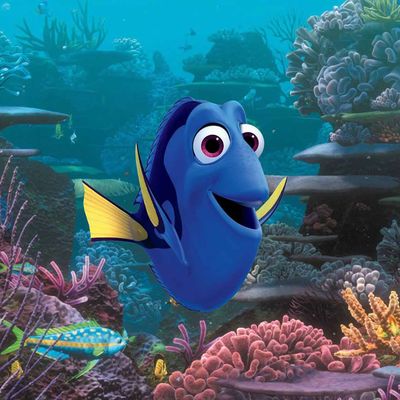
Is Finding Dory, the new Pixar movie, all that, as you’ve no doubt heard? No and yes.
No because it feels in its opening scenes like a sequel, made for no burning creative reason, whereas Inside Out, Up, Wall-E, and Finding Nemo were riskier works that could have bombed as easily as been boffo. Finding Dory leaves nothing to chance: It opens sweety-cute, it ends sweety-cute. Formula-wise, it hugs the shore.
Yes because directors Andrew Stanton and Angus MacLane and their stable of sterling writers and artists have miracles up their sleeve. They have the biggest, busiest, and best sleeve in the business.
We meet the short-term-memory-impaired Dory as a big-eyed little fish — her eyes are as large as her head. Her doting mom and dad are teaching her to navigate a world in which disorientation is the rule; and as you watch, you know she’s fated to lose her parents, her memories, and even large parts of her identity. But the movie doesn’t show you how she became separated from her family until much later, filling in the details as she remembers them. That makes for a big payoff down the road but a perfunctory start. Finding Nemo has the more arresting opening.
And really, looking back, “arresting” is understating it. The opening of Finding Nemo was horrific: a massacre in which the clown fish Marlin lost his entire family — a wife and 399 eggs — apart from one son. Predictably, he overprotected that son, and predictably that son —Nemo — became reckless in defiance. What followed was scary, painful, and emotionally knotty: Marlin needed to allow his son to be more self-reliant; Nemo had to navigate more soberly. But the movie was also a riot of colors and textures — and a riot, period, thanks to a great script and the vocal pairing of Albert Brooks as the semi-hysterical Marlin and Ellen DeGeneres as the sweet, befuddled family friend Dory, whose interjections were often poignantly absurd.
In Finding Dory, the action proper begins a year after Finding Nemo, when Dory has a flashback — the remembrance triggered not by a madeleine but a stingray migration. She thinks she remembers a family some place, in California, maybe. But she seemed so scattered in her first, flatly written scenes that I got a little bored. Maybe building a movie on a one-joke sidekick was a mistake, I thought. My mind drifted to dumb places: How do these fish know the distance from the Great Barrier Reef to California? How can they speak English?
But then the studio’s peculiar genius kicked in and everything went swimmingly.
The main setting of Finding Dory is a California rescue-and-rehab aquarium modeled on an actual one in Monterey Bay. (Relax, it’s not SeaWorld!) It has lots of different buildings — multiple stages for intricate slapstick set-pieces as Dory flops around (she reads signs and maps) looking for her parents. Visitors are guided over loudspeakers by the recorded voice of Sigourney Weaver, whom the fish regard as a friend and whose name becomes a running gag. Seriously, just hearing the words “Sigourney Weaver” gives you the giggles. But you also might think, “I miss Sigourney Weaver. What’s she doing these days? She is a friend to all living creatures.” (Too bad she doesn’t appear in the touch-tank scene, which is like a mini-horror movie. Children’s arms plunge into the water like the trunks of giant aliens and carry off howling starfish to be petted and/or mauled.)
You might be thinking, “Given that fish need to be in water, how does Dory travel among the complex’s buildings?” Good question. She’s helped by the movie’s most marvelous new character, Hank, voiced by Ed O’Neill. He’s an octopus. Make that a septopus — his term — since he lost an arm in an accident he’s still sore about. Hank is a selfish loner who doesn’t think he can survive if he’s returned to the ocean. He would prefer to go to an aquarium in Cleveland. On land, though, he’s super-resourceful. He can turn any color, slither anywhere, steer any vehicle. He’s the most delightfully dexterous creature since Bugs Bunny — and with three extra limbs to play with. I can’t do justice to the joy of watching him zigzag among human visitors in a baby carriage with Dory balanced in a sippy cup on his lap. I can’t even begin to do justice to the movie’s climax, which takes place on a highway. The silliness escalates — the jokes build and build and pay off — until you’re slaphappy, punch-drunk, primed for anything.
Some people might find it jarring that Finding Dory gets a lot of comic mileage out of disability — Dory’s, obviously, but also a perpetually disoriented whale shark named Destiny (voiced by Kaitlin Olson), a Beluga named Bailey (voiced by Ty Burrell) with a neurotic lack of faith in his sonar, a moronic sea lion, and a seriously brain-deficient bird. But the movie also shows that with sufficient heart you can triumph over those supposed limitations. (Look, if jokes centering on impairment were a crime, 90 percent of the comedy profession would be in jail.) At times, though, Finding Dory gives you a glimpse of a more terrifying disorientation: You see the world through Dory’s eyes — spinning, objects dissolving along with her memories, a world with nothing to hang onto. Like its predecessor, Finding Dory suggests that existence is discombobulating, and that it’s families — real and surrogate — that keep you, er, combobulated.
In the end, is Finding Dory better than Finding Nemo? It’s funnier and more intricate, but the tears it jerks have been jerked before. It’s not as original, not as deep. Best to think of it as the kiddie pool of your childhood dreams. You never want to stop splashing and being splashed. You wish you were a fish.


